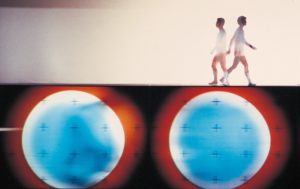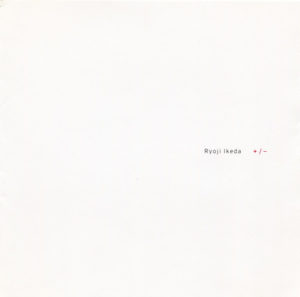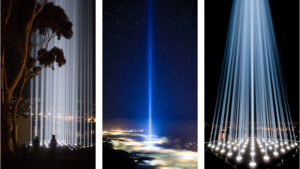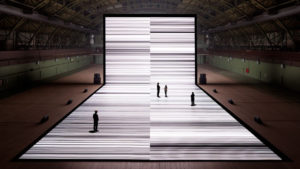[February 9, 2022 | Season 2, Ep. 8 | Barbara London Calling]
Barbara London: Today, I’m speaking with visual artist and composer Ryoji Ikeda. Born in 1966 in Gifu, a city in central Japan, Ryoji now divides his time between Paris and Kyoto. He works with sound in its raw state—that is, sine tones and noise, often in frequencies at the edge of human perception. Ryoji, thank you for joining me.
Ryoji Ikeda: Thank you for having me.
[Continue reading for full transcript.]
Transcript
BL: You emerged as a sound artist and DJ in the 1990s, when minimal techno music was on the rise. How did you become involved with music?
RI: I attended university in Tokyo during the late 1980s. At that moment the situation in Japan, especially the economy in Japan, was bubbling. There was lots of money around, when luxury hotels and other things were rapidly being built up, much like in China nowadays. At the same time, there were many clubs, not only live performance venues, but also nightclubs with DJs. It was a new phenomenon in Japan, and I went to nightclubs mostly every night with friends. That’s how I knew about house music, DJing and hip-hop. This was my entrance to music.
BL: We met in Tokyo, where you had become an audiovisual producer at Spiral Gallery. Spiral was and continues as an au courant venue, with a restaurant, theater and gallery, at the intersection of music, art, film and fashion. I’d love to know about your time at Spiral. What was the scene and what impact did being at Spiral have on your work?
RI: Actually, I don’t usually tell that story about my former job. But I started working at Spiral as a dishwasher, like a part-time job in a restaurant. I was a waiter and worked at the bar. It was a normal part-time job. Then I became friends with the people within the Spiral organization. I don’t remember that much, but I had a contract with Spiral doing AV, as an audiovisual producer. I organized and produced over 400 gigs in the live venue in the basement of the Spiral building. It was mostly what at that moment was called world music: drummers from Africa or reggae, dub, calypso, Caribbean music, Mongolian singers—all these things I booked and managed. Also, I programmed some experimental films, including the premiere in Japan of Derek Jarman’s Blue (1993), his last film. I was working for artists. I was always behind the curtain. I was taking care of everything from catering to contracts. Then I met Dumb Type, the Japanese artist collective, and that was a shock for me.
BL: So it was at Spiral in Tokyo that that you met Dumb Type, a Kyoto-based activist artist collective whose performances and installations critiqued the role of technology in contemporary society. They were really critical, but they did it in such an elegant, beautiful way. What did you learn from them, and from Teiji Furuhashi, who was the visionary artist at the center of the Dumb Type collective.

RI: It wasn’t only Teiji; I learned everything from Dumb Type. We are the same generation and really quickly we became friends. I was a producer for certain projects of Dumb Type there, but there was no borderline between producer and the members. Quite naturally I became a member, and then I joined their tours. We went all over the world for 10, 12 years. I learned everything—how to do a sound check in the theater, how to load in all the equipment, the scheduling, the contract and the “blah, blah, blah.” Dumb Type functioned as a school for me and for the members, too. They were from art school in Kyoto, where some members studied Japanese painting, sculpture, and decorative design. But they were doing absolutely nothing related to what they had studied. Some people studying Japanese painting became lighting designers. Teiji, I don’t know what he was studying, but he was obviously into music and choreography and the drag scene and whatever. Each person, each member had a very unique background and sensibility. It’s a collective, but it was very, very different individuals. I learned a lot from Teiji about counterpoint. He was great. He’s not really well known as a composer, but he was a really good drummer. He was very good with rhythms, with polyrhythms. It was a very strange rhythmic ensemble. He was really able to make a structure. His counterpoint was between video content and lighting and the choreography and the music itself; it was his orchestration. It was a shock for me. This was really influential for me and still is nowadays. What he’d done had such a big impact and was so inspiring, technically, philosophically, conceptually, everything. This is his intellectual side. Right? You knew him very well.
Teiji Furuhashi, Lovers. 1994. Computer controlled, five-channel laserdisc/sound installation with five projectors, two sound systems, two slide projectors, and slides (color, sound).
BL: He kept so much in his head. I think you and I once had a conversation about that. It was the genius of him. It was all in his head.
RI: Everybody knew him, but no one really knew him, because he had so many facets, so many aspects. He could hold a very conceptual conversation. I could have really great conversations with him on many topics—street culture, underground culture, and of course the role of gender in society. It’s really amazing.
BL: You were touring with Dumb Type internationally and saw how they were often pigeonholed as “very Japanese” and “very Zen.” I feel that must have been unbelievably annoying. I think you encountered a similar, superficial reception to your 1996 album, +/-, which was released through the outstanding Touch label. I’m curious, how does or did that type of criticism affect you and your work?
RI: We can’t escape from this stereotypical image from anyone. Even when I have a project in a Middle Eastern country, an Arabic country, but especially in Western, people have a very strong intellectual image of Japan, like Zen or high tech, like a Toyota or a Sony product. But now I try to play with it. I don’t want to argue. Now I try to discuss something about the similarity, not the difference between us. Because first, we are human beings. I’m a man. Our gender issues are a bit sensitive now, but I try to make a more productive conversation, because we are similar in certain ways. Otherwise, like the French and the Japanese, we talk just about differences. We have funny conversations, which is not really productive.
BL: In Japan, who besides Dumb Type might have opened your eyes or your brain?
RI: Dumb Type’s contemporary, there is a similar artist collective called MMM, and Tokyo Grand Guignol whose leader is Norimizu Ameya (飴屋法水). He’s still alive, in Tokyo. They are a really big influencer for all artists, for the artistic community. In Kyoto, in Kansai, I can say Dumb Type. Dumb Type is always very Kyoto-style sophisticated, but the message is so strong, even arrogant activism. But the other one, MMM, is completely “dead tech.” They constructed a robot. Like SRL [Survival Research Laboratories, the American performance art group that pioneered the genre of large-scale machine performance, founded in 1978], they destroyed their building and they put it on a fire. It’s beyond punk; it’s crazy guys. It was a huge influence in the 1980s. Artists in Japan were heavily influenced by both of them, MMM and Dumb Type. I was lucky to be involved in Dumb Type. I was a huge fan, and I still am. They started out in the 1980s, and I joined in the early 1990s. Still, I feel like I’m a newcomer, even after a decade of activity with them. Dumb Type members are over 60 years old and they have kind of slowly retired.
Dumb Type, OR. 1995. Performance. Festival VIA, Le Manège Scène Nationale. Théâtre du Manège, Maubeuge, France, 1997. Image, courtesy Dumb Type.
BL: I have read that your experience around the reception of your album +/- caused a big leap in your work. I want to know what happened. When did you start getting interested in sound in its raw stage?
RI: In the early 1990s when I was DJing in clubs, I DJ’d experimental music, collage without beat, soundscapes from bossa nova, film music, whatever, all kinds of electronic sounds. I just mixed everything. I had a huge archive of this music and sound material to be collaged, to be mashed up. Then suddenly I was fed up, because there was too much and I couldn’t archive or compile it all. Then I threw away everything and chose just one sound, the so-called sine wave, and also white noise. The sine wave is actually the building block of sound. Your voice, my voice, the sounds of cars, anything can be reduced of a bunch of sine wave combinations. This is scientific. But at the same time, white noise contains full random frequency, and is completely the opposite. It is like yin yang, you know? I was really fascinated to use just two elements. Then I constructed the album +/- out of just two sounds.

Image, +/- CD cover.
BL: You said your working process can be very abstract or highly conceptual, with a lot of back and forth between the brain and your hand. Do you have a typical way you conceptualize and make work?
RI: We can’t see music. We can’t see sound. And what is sound? We can hear, we can listen. In a sense, sound is the vibration of air. To me, sound is very much a property of physics, a physical phenomenon. Sound can be music, of course, but sound is sound. What is music? I think music means a mathematical structure. With music, the material is sound, but if it’s only sound, it’s just sound. With structure, sound can be music. Even without structure like John Cage’s 4’33” composition, he twisted a non-structure, but which is based on a structure. Music is like this for me and is really mathematics. Sound is really phenomena.
I think it’s both. Balance is very, very important for me, because my concerts and everything are so physical. It’s a big bass sound. This is very much physics for me. But how to compose? It is very much about operational numbers and the mathematical structure. I really like the notions expressed in the words of [Gottfried] Leibniz [1646-1716], the mathematician and philosopher of so many years ago in Germany. He said, music is nothing but unconscious arithmetic. The pleasure we obtain from music comes from counting, but counting unconsciously, and music is nothing but unconscious arithmetic. It’s like counting, like mathematics.
BL: This leads us very easily into your installations. I’m not sure, but I think one of your very early installations was spectra from 2001, which is about how light and sound materialize themselves in the world. Was this a natural evolution for how the work came about?
RI: It really came from my experience with Dumb Type, because when we created a performance piece, of course I was taking care of the music. But at the same time, I could say anything about lighting and the choreography or stage design. Anything. At the same time, a performer could complain about my music, and vice versa because there was no leader. I developed my sense of diversity in art forms during my collaboration with Dumb Type. spectra is an early piece, which is about light, white light. How white, which is the color temperature, is equivalent to sunlight, which is actually very, very white. It’s not like orange and yellow, but white. But then it contains the full spectrum, which is like white noise. For visual art, I just started about light. It’s just maximum information, just white light. It contains the entire spectrum of color. Then I started a kind of variation. Light into pixels and the breed of video, combined with the sound structure and then developing, evolving step by step for the last decade.

BL: Let’s jump forward ten years to 2011. I entered New York’s Park Avenue Armory to experience your exhibition, “the transfinite.” I walked into the vast dark space. I promptly took off my shoes and lay right down in the middle of your pristine white linoleum floor. I became really lost in the pulsating audio-visual environment around me. It was really mesmerizing being surrounded by this pulsating light, the patterns, the volume, the shadows, the electronic sounds and the rhythm. How do you orchestrate all of that electronic data to conjure up something that is such a powerful experience for your audience?
RI: It’s already been ten years! It’s kind of scary how time flies. I remember this piece as being really quite large scale. When I got the commission, I was thinking, what am I going to do? But within five minutes in the site I actually decided, because that big space is so inspirational. It was totally instinct, not really calculation. The concept always falls into place later. Then I thought I want to do something very physical, but which is not a concert, not like an exhibition, but something in between, something kind of uncategorizable.
Then I did it, everything is live, and experience is everything. I can’t explain it with words. You had a certain feeling and which is your answer because for this kind of piece, the work really speaks for itself. At least the work speaks better than me. If I say something, I will take the visitors’ freedom of interpretation away. I just leave it. Yes, it was a monumental project. Since then, I’ve made many similar works, even much bigger. But now I am shrinking them. It was too big. It’s the size really that sometimes matters. Anyway, that was a really great experience for me, as an artist.

BL: Let’s now move forward to a more recent work, the one at the Venice Biennale Arsenale in 2019. Again, I lay right down to the middle of data-verse , and again, the installation relied on what you might call an algorithmic way of working, where mathematics was used as a means to capture and reflect upon the world around us. Is that accurate? You have said that music and math are brothers. What did you mean by saying that?
RI: If someone wrote that, maybe that’s right for him or her because there’s no definite answer. Your feeling is everything. I always feel I make something and I always feel I make half; [it needs] your participation, your appreciation, your interpretation, whatever. When you see the piece, when you experience the piece, the piece itself is completed. I don’t want to say, this is my piece 100%, which is too pretentious. I made half. That’s why without people, it doesn’t make any sense. It’s like when you go to the restaurant, without people the chef has no meaning. Perhaps the chef has made a delicious dish for their own sake, their own technique or whatever, but they need an audience. That’s how we artists function in society, somehow.
Our data-verse is a lot of dataset. It’s a big dataset, since early 2000, 2002-3. It’s been already sixteen, seventeen, eighteen years. Because I started an artistic challenge to compose data, because I compose sound, white noise, sine waves into musical composition, into music. I compose light-like pixels into video content. Then I wanted to start to compose data itself. The notion of data is very interesting, because like a sound you can’t actually touch it in that material. It can be expressed by numbers and the words and letters. But in fact, it’s not because everything is a combination of zeros and ones, which is very, very good to cook for me as a composer. It’s really challenging to access the full human genome, DNA sequence and galactic coordinators, trillions of stars out there, and the proteins and amino acids, everything. Over the last fifteen, sixteen years, I’ve collected everything from NASA or CERN, particle physics, quantum mechanics. I have an incredibly enormous data set.
Ryoji Ikeda, data-verse 1. 2019. Installation. Venice Biennial.
The question is how to use it. People said, just do a visualization, but it’s not enough. It has to be beautiful or aesthetically striking, even ugly or whatever. It’s just material, like color is for a painter. It’s everything based on composition for me. In that sense, I’m a composer who cannot read a score, but I love to compose all those different kinds of elements and materials, which, as I said earlier, was a big inspiration from Teiji. That’s why an installation works. It’s not really visual art, sometimes it’s like a movie, video art, and a concert, even. I want to blur the borders between genres of artworks, art forms.
BL: Well, that’s beautiful. Thank you for being so generous. I’ll move on to my last question. This year it has been very difficult to travel. I was so sorry to miss your retrospective at 180 Studios in London, organized by Fact Magazine and the Vinyl Factory in collaboration with Audemars Piguet Contemporary.
data-verse trilogy. 2021. Installation with three high-definition DCI-4K video projections accompanied by a minimalist electronic soundtrack. “Ryoji Ikeda Exhibition” at 180 The Strand, London, curated and produced by The Vinyl Factory and Fact Magazine in collaboration with Audemars Piguet Contemporary. https://vimeo.com/566111687
It’s been described as a multisensory exploration of light and sound, and it had to have been a very complex work to undertake during the pandemic. This leads to my last question, something I’m asking each of my guests. Given the ups and downs of the last 18 months and the struggles we’ve all faced in trying to adapt, how has technology affected you and your practice?
RI: When you look back at the history of art, every artist takes a kind of cutting-edge technology at that moment, even Johannes Vermeer, even Mozart and the fortepiano. At that moment [from 1785 until Mozart’s death in 1791], the fortepiano was really, really cutting-edge technology. Why not? When we artists use computers, this still seems to unsettle all those curators. They really try to make artists be in a kind of cocoon in the beautiful painting world. But when I say “contemporary” artists, we really need their contemporariness. Because every single businessman, every student, now they can’t live without their iPhone and laptop. Why not artists? I just use technology like everyone else. This is my answer. I’m kind of neutral. I’m not really positive, negative. I just follow what we have available.
BL: That’s a beautiful way to end. I want to thank you very, very much for taking the time out of a very busy schedule to join me in today’s conversation. Thank you.
RI: Thank you very much, Barbara.
—
Support for Barbara London Calling 2.0 is generously provided by the Kramlich Art Foundation.
Be sure to like and subscribe to Barbara London Calling so you can keep up with all the latest episodes. Follow us on Instagram at @Barbara_London_Calling and check out barbaralondon.net for transcripts of each episode and links to the works discussed.
The series is produced by Ryan Leahey, with production assistant Vuk Vuković. Web design by Vivian Selbo. Special thanks to Lee Ranaldo for graciously providing our music.
This conversation was recorded September 13, 2021; it has been edited for length and clarity.
Images

Teiji Furuhashi, Lovers. 1994. Computer controlled, five-channel laserdisc/sound installation with five projectors, two sound systems, two slide projectors, and slides (color, sound).
Dumb Type, OR. 1995. Performance. Festival VIA, Le Manège Scène Nationale. Théâtre du Manège, Maubeuge, France, 1997. Image, courtesy Dumb Type.

Image, +/- CD cover.


data-verse 1. 2019. Installation. Venice Biennial.
data-verse trilogy. 2021. Installation with three high-definition DCI-4K video projections accompanied by a minimalist electronic soundtrack. “Ryoji Ikeda Exhibition” at 180 The Strand, London, curated and produced by The Vinyl Factory and Fact Magazine in collaboration with Audemars Piguet Contemporary.
